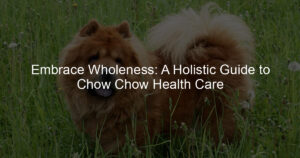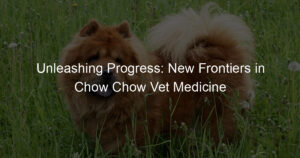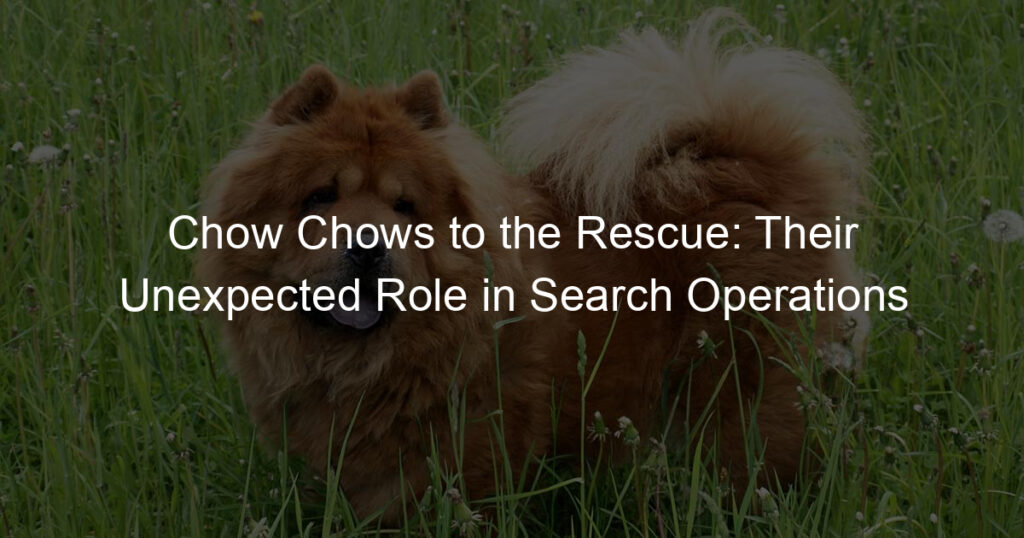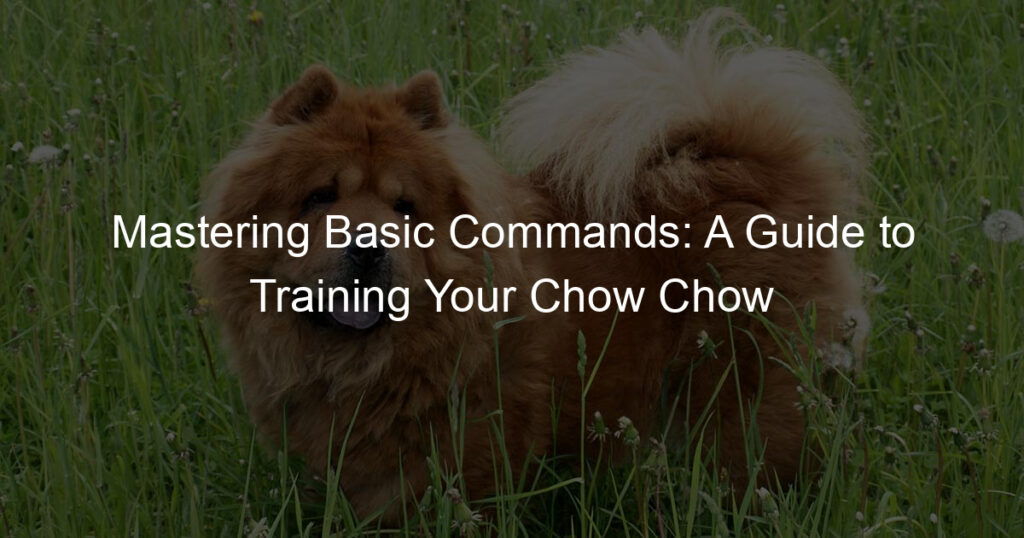Introduction: Preparing for Pet Emergencies
When it comes to our beloved pets, especially the unique and charming Chow Chow breed, being prepared for emergencies is crucial. In this blog post, we will delve into the importance of emergency preparedness and discuss specific health issues related to the Chow Chow breed.
- The Importance of Being Prepared for Pet Emergencies
Emergencies can occur at any time, and when they involve our furry friends, they can be particularly distressing. Being prepared for such situations can make a significant difference in the outcome. According to the American Veterinary Medical Association, about 25% of all pets would survive if just one pet first aid technique was applied before getting emergency veterinary care. This statistic highlights the importance of being prepared for pet emergencies.
- Specific Health Issues Related to the Chow Chow Breed
Chow Chows are a unique breed with specific health issues that owners should be aware of. These include hip and elbow dysplasia, eye problems such as entropion, and skin conditions. According to the Chow Chow Club, these dogs are also more prone to certain types of allergies and autoimmune diseases than other breeds. Being aware of these specific health issues can help you recognize symptoms early and seek prompt veterinary care, potentially saving your pet’s life.
Stay tuned as we delve deeper into understanding Chow Chow health care, emergency first aid for dogs, and planning ahead for dog emergencies. Our goal is to help you ensure the health and safety of your Chow Chow.
Understanding Chow Chow Health Care
As a Chow Chow owner, understanding the health care needs of your pet is crucial. This breed, like any other, has its unique set of health issues that need to be addressed promptly to prevent emergencies.
Common Chow Chow Breed Health Issues
Chow Chows are generally healthy, but they’re susceptible to certain health conditions. Not all Chows will get any or all of these diseases, but it’s important to be aware of them if you’re considering this breed.
- Overview of common health issues in Chow Chows
- How these health issues can lead to emergencies
Chow Chows are prone to several health issues including hip and elbow dysplasia, eye disorders like entropion, and skin conditions. They can also develop certain heart conditions and are at a higher risk for gastric torsion, also known as bloat. It’s important to be aware of these potential health issues to ensure your Chow Chow gets the care it needs.
Many of these health issues, if left untreated, can lead to serious emergencies. For instance, bloat is a life-threatening condition that requires immediate veterinary attention. Similarly, untreated hip dysplasia can lead to severe pain and mobility issues. Regular vet visits and early detection are key to preventing these health issues from becoming emergencies.
Understanding these health issues can help you take better care of your Chow Chow and prevent potential emergencies. Regular vet visits and health checks are crucial for early detection and treatment of these conditions.
Regular Health Checks for Your Chow Chow
Ensuring the health and longevity of your Chow Chow involves more than just providing them with a balanced diet and regular exercise. Regular health checks play a crucial role in maintaining your pet’s overall wellbeing. Let’s delve into the importance of these checks and what you can expect during a Chow Chow health check.
- The Role of Regular Vet Visits in Preventing Emergencies
- What to Expect During a Chow Chow Health Check
Regular vet visits are a proactive approach to your Chow Chow’s health. These visits allow for early detection of potential health issues, which can prevent emergencies down the line. According to veterinary studies, regular health checks can help detect diseases like hip dysplasia, eye problems, and skin conditions, which are common in Chow Chows. By catching these issues early, treatment can be started sooner, potentially saving your pet from discomfort and you from costly emergency vet visits.
A typical health check for your Chow Chow will involve a thorough physical examination. The vet will check your pet’s teeth, ears, and eyes, and listen to their heart and lungs. They will also examine the skin for any signs of infections or parasites, and the joints for any signs of discomfort or stiffness. Blood tests may also be conducted to check for any underlying issues. Remember, your Chow Chow’s health check is also an excellent opportunity for you to raise any concerns or questions you may have about your pet’s health or behavior.
In conclusion, regular health checks are an essential part of your Chow Chow’s healthcare routine. They not only help in early detection and prevention of potential health issues but also provide an opportunity for you to discuss your pet’s overall wellbeing with a professional. So, make sure to schedule regular vet visits for your furry friend.
Emergency First Aid for Dogs: A Canine First Aid Guide
When it comes to our beloved Chow Chows, emergencies can happen at any time. It’s crucial to know what to do in these situations to ensure the safety and health of our pets. In this guide, we’ll go over some essential first aid tips for Chow Chows.
First Aid Tips for Chow Chow: What to Do in an Emergency
Emergencies can be scary, especially when they involve our furry friends. Here are some steps to follow when your Chow Chow is in distress and how to safely transport them to the vet.
- Steps to take when your Chow Chow is in distress:
- How to safely transport your Chow Chow to the vet:
First, stay calm. Your Chow Chow can sense your panic, which might make them more anxious. Assess the situation carefully. If your Chow Chow is unconscious, check for breathing and a heartbeat. If they’re conscious but in pain, try to comfort them without causing more harm. Call your vet immediately and describe the situation as accurately as you can.
When transporting your Chow Chow to the vet, it’s important to keep them as calm and comfortable as possible. Use a blanket or a pet carrier to move them. Try to minimize movement, especially if they might have a broken bone or internal injury. If possible, have someone else drive so you can comfort your Chow Chow during the journey.
Remember, these tips are not a substitute for professional veterinary care. Always consult with your vet in case of an emergency. Being prepared can make a big difference in ensuring the health and safety of your Chow Chow.
First Aid Supplies for Your Chow Chow
When it comes to your Chow Chow’s health and safety, being prepared is key. One way to ensure you’re ready for any situation is by having a well-stocked pet first aid kit. This kit should contain essential items that can help you provide immediate care for your Chow Chow in case of an emergency.
- Essential items for your pet first aid kit
- Bandages and gauze pads for covering wounds
- Antiseptic wipes or solution to clean wounds
- Scissors for cutting bandages or hair
- Tweezers for removing splinters or ticks
- A digital thermometer to check your pet’s temperature
- A pet first aid manual for reference
- How to use common first aid supplies
- Use bandages and gauze pads to cover wounds and prevent infection. Make sure not to wrap them too tight as it can cut off circulation.
- Antiseptic wipes or solutions can be used to clean wounds before bandaging. Avoid using human antiseptics as they can be harmful to pets.
- Scissors can be used to cut bandages to the right size or to trim hair around a wound. Always be careful not to cut your pet’s skin.
- Tweezers can be used to remove splinters or ticks. Make sure to pull straight out to avoid leaving any parts behind.
- A digital thermometer can be used to check your pet’s temperature. Normal body temperature for dogs is between 101 and 102.5 degrees Fahrenheit.
There are several items that are crucial to have in your pet first aid kit. These include:
Remember, these are just the basics. Depending on your Chow Chow’s specific needs, you may need to include additional items in your kit.
Knowing how to use the items in your pet first aid kit is just as important as having them. Here are some tips:
Always consult your vet or a pet first aid manual if you’re unsure about how to use any of these items.
By having a well-stocked pet first aid kit and knowing how to use the items in it, you can help ensure your Chow Chow’s health and safety in case of an emergency. Remember, always consult with your vet if you have any questions or concerns.
Dog Emergency Preparation: Planning Ahead
As a Chow Chow owner, it’s crucial to be prepared for any emergencies that may arise. This involves creating a comprehensive pet emergency plan and practicing it regularly with your Chow Chow.
Creating a Pet Emergency Plan
Creating a pet emergency plan is a proactive step towards ensuring the safety of your Chow Chow. Here are some key elements to consider:
- Key Elements of a Pet Emergency Plan
- How to Practice Your Emergency Plan with Your Chow Chow
Firstly, identify a safe place in your home where you can take your Chow Chow during an emergency. This could be a room with no windows or a basement. Next, prepare an emergency kit that includes essential items such as food, water, medication, and a first aid kit. Also, keep a list of emergency contact numbers, including your vet’s number, handy. Lastly, ensure your Chow Chow is microchipped and wears a collar with identification tags at all times.
Practicing your emergency plan with your Chow Chow is just as important as creating it. Start by familiarizing your Chow Chow with the safe place in your home. You can do this by spending time with them in this area and rewarding them with treats. Next, simulate emergency situations and observe your Chow Chow’s reaction. This will help you identify any areas of your plan that need improvement. Remember, the goal is to make your Chow Chow feel safe and comfortable during an emergency.
In conclusion, being prepared for emergencies is a critical aspect of responsible pet ownership. By creating and practicing an emergency plan, you can ensure the safety and well-being of your beloved Chow Chow.
Training for Pet Emergencies
When it comes to our beloved Chow Chows, we want to be prepared for any situation. Training for pet emergencies is an essential part of being a responsible pet owner. This includes understanding the benefits of pet first aid training and knowing where to find these crucial courses.
- Benefits of Pet First Aid Training
- Where to Find Pet First Aid Courses
First aid training for pets, especially for Chow Chows, offers numerous benefits. It equips you with the knowledge and skills to handle emergencies effectively. You’ll learn how to recognize signs of distress, perform CPR, and treat minor injuries. This training could be the difference between life and death for your pet. According to a Wikipedia article, pet first aid is a valuable skill that can save pets’ lives and reduce their suffering during emergencies.
Finding a pet first aid course is easier than you might think. Many organizations offer these courses online, allowing you to learn at your own pace from the comfort of your home. Websites like the American Red Cross and Pet Health Academy provide comprehensive courses tailored to different breeds, including Chow Chows. Always ensure the course you choose is accredited and taught by professionals in the field.
In conclusion, pet emergency training is a vital tool in ensuring the safety and well-being of your Chow Chow. It empowers you to act swiftly and confidently during emergencies, potentially saving your pet’s life.
Conclusion: Ensuring Your Chow Chow’s Health and Safety
In conclusion, the health and safety of your Chow Chow is of utmost importance. The key to ensuring this is being prepared for emergencies and providing ongoing care. Let’s recap some of the key takeaways and discuss the role of ongoing care in preventing emergencies.
- Recap of key takeaways for Chow Chow emergency care
- Knowing the signs of common health issues in Chow Chows such as hip dysplasia, entropion, and skin problems.
- Having a canine first aid kit on hand and knowing how to use it.
- Being familiar with your nearest emergency vet clinic and their hours of operation.
- Understanding how to perform basic first aid procedures such as bandaging a wound, performing CPR, and what to do in case of choking.
- The role of ongoing care in preventing emergencies
Emergency care for your Chow Chow involves understanding their unique health needs and being prepared to act swiftly in case of an emergency. This includes:
Ongoing care plays a crucial role in preventing emergencies. Regular vet check-ups can help detect potential health issues early, before they become serious. A healthy diet and regular exercise can also keep your Chow Chow in good shape and prevent obesity, a common issue in this breed. Additionally, regular grooming can help prevent skin issues, a common health problem in Chow Chows.
Remember, prevention is always better than cure. By providing ongoing care and being prepared for emergencies, you can ensure your Chow Chow lives a long, healthy, and happy life.
For more information on Chow Chow health and safety, visit the Chow Chow Wikipedia page.














